The most expensive coin in 2013
 Bashny.Net
Bashny.Net
"Good Price" Mercedes "!" - Was astonished Guest auction, held at the Marriott, a well-known Moscow collector and dealer. "But someone has become the happy owner" - he replied with a smile neighbor. The conversation was at auction numismatic firm "Coins and Medals". Just the auctioneer announced the sale of 5 million rubles a copper penny in 1704 signed MD - one of the rarest coins reign of Peter I. And this price has not yet been a record.
If a couple of years ago, the top lots were numismatic auctions coins, which went 2-4 at the price of 5 million rubles, but this year the cost - 5-7, 5 million rubles. From January to October auction firm "Coins and Medals", "Alexander", "East European antique house", "Imperiya" and "Russian House numismatic" coins sold over 4600 pre-Petrine Russia, the Russian Empire, the Soviet Union and modern Russia in excess 500 million rubles (excluding fees from customers). With about 100 coins left at the price of 1 million rubles to 10, 2 million rubles.
"High demand, as always, are rare things, especially supersohrannosti", - said Igor Lavruk, CEO "of coins and medals", the largest in terms of revenue numismatic firm. - It is good to buy very cheap coin - a sign that the market appeared novice collectors. " However, in the medium price segment (coins from 300 000 to 900 000), the situation is different - many items are removed from the auction due to lack of bids. Most wealthy collectors such coins are already available, and beginners are not ready to buy them. Nevertheless, says Lavruk lower price will no longer: the post-crisis recession has passed. The market is clearly on the rise, agrees banker and collector Sergei Yunin that established in late 2012. "The Eastern European antique house." "The more I was immersed in the antique market and, in particular, in numismatics, the more he did not believe his luck! - He says. - Agreed several favorable factors, and first among them - the extreme volatility in the financial markets, traditionally defined escape into gold, the Swiss franc, antiques, real estate ».
Introducing the most expensive lots in Moscow numismatic auctions, prices of which are in the course of trading exceeded 5 million rubles.
Poltina 1843 (obverse)
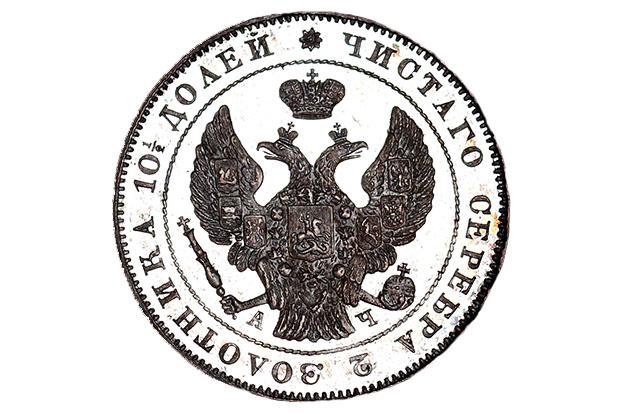
Price: 10, 2 million rubles
If this poltina in 1843 was released at the Warsaw Mint, now even at UNC (with no trace of treatment) would cost no more than $ 5,000. But it is minted in St. Petersburg as a proof - polished stamps on the polished workpiece and therefore is ten times more expensive. As a rule, proof coins were intended to demonstrate the quality of the mint, and coincided with the dates of the draw stamping. In 1843, at the Saint Petersburg Mint poltinas not minted for circulation and a copy of proof, apparently, produced on special order.
Poltina 1843 (reverse)

Being one of the rarest coins middle of the XIX century, in the June auction "East European antique house" poltina went for 10, 2 million rubles. It has been reported that the coin comes from the old foreign collections and put up for auction for the second time in the history of numismatic auctions. It seems that it was sold in October 2012 at an auction Sincona for 240,000 Swiss francs (about 8, 7 million rubles at the exchange rate). With commission auction houses, the previous owner earned on resale poltinas not too much - about 500 000 rubles.
Ducat 1729
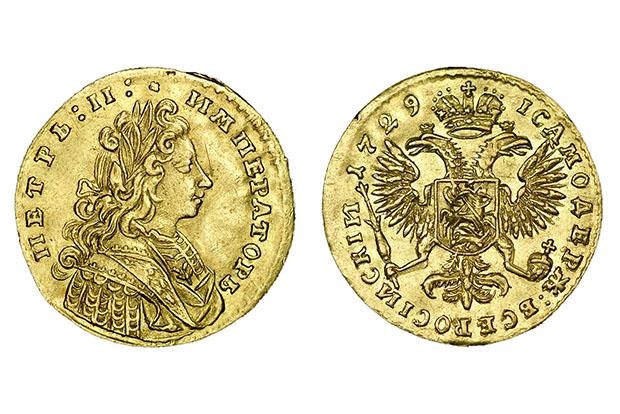
Price: 5, 3 million rubles
Emperor Peter II, grandson of Peter the Great, the rules for long - less than three years. Gold coins were minted with him only once - in 1729, when the College of Foreign Affairs of the needed gold for their own needs. The mint raw gold was not enough, so the redistribution of low-value products went from the Armory and gold dvuhrublevye coins minted during the reign of Peter I and Catherine I. The College of Foreign Affairs received 17,000 ducats.
But over the centuries, thousands of "disappeared" and turned into dozens. Peter II gold coins are considered very rare. In March 2013 gold coin in 1729 in the state AUNC (almost without a trace of treatment) at auction "Alexander" went for 5, 3 million rubles. Appears on its face, this is the coin in November 2012, was sold at auction Numismatica Genevensis 85 000 Swiss francs (2, 8 million rubles at the exchange rate).
1 ruble 1839 (obverse)
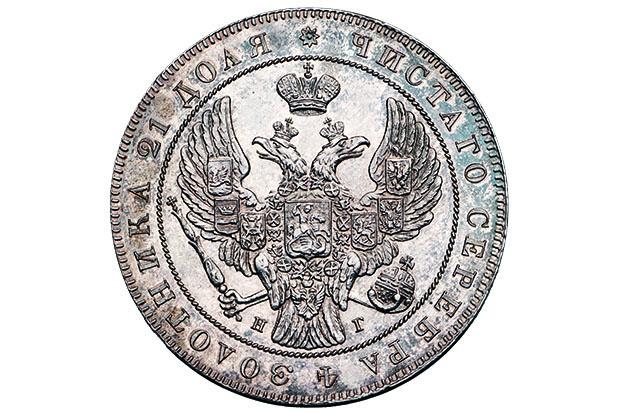
Price: 7, 5 million rubles
The circulation of silver rubles during the reign of Nicholas I counted in millions and hundreds of thousands of pieces. It was only in 1839 ruble coins minted just 30,000, including multiple instances as proof.
1 ruble 1839 (reverse)
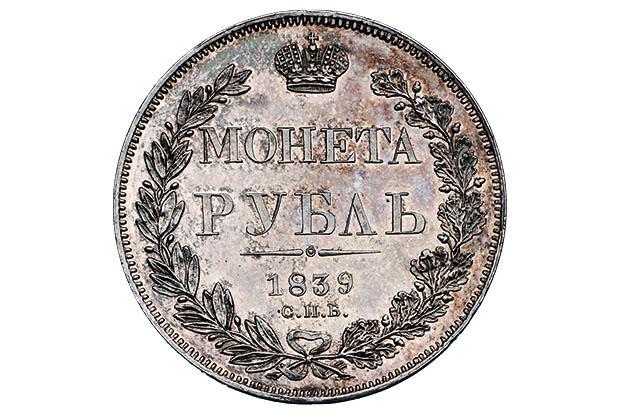
In October 2013 at an auction firm "Coins and Medals" ruble 1839 proof was bought for 7, 5 million rubles. Ten years earlier, the same auction house sold the same coin for 600 000 rubles. For comparison, the stock exchange gold for 2003-2013 years has risen in price in 3, 4 times.
1 ruble 1801 (reverse)

Price: 7, 25 million rubles
In the year of accession to the throne of Alexander I ruble coins for circulation were not issued. Therefore available in the collection rubleviki with a portrait of the young emperor, eagle stamp and the date "1801" refers to trial. For the most part they considered to remake - coins minted authentic and refined stamps in the middle - the second half of the XIX century.
However, authoritative numismatist-scholar Basil Uzdenikov believed that no trial rubles did not exist, and for remakes was used unapproved version of the portrait medal stamp to commemorate the coronation of Alexander I. Whatever it was, Euro 1801 has always been highly valued by collectors.
1 ruble 1801 (obverse)
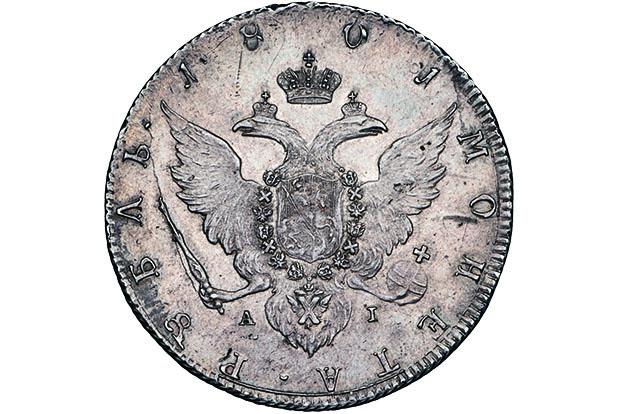
Known variants of these seven rubles differing nuances of issue and details front and back sides. The rarest of them who still believe this trial, in October 2013 was sold at auction "Coins and Medals" for 7, 25 million rubles. The same coin, but a better safety at the April 2006 auction went for 2, 8 million rubles.
Ducat 1712

Price: 6, 1 million rubles
Gold coins in Tsarist Russia was referred to a ten banknotes, as in Soviet times, and coins in the European Champion ducats (in the beginning of the XVIII century, one gold piece corresponded to about 2-2, 25 Russian rubles). They began to mint under Peter I for International Settlements, and for the sake of political prestige. His gold in Russia was not, and for coinage Treasury purchased through Siberian merchants Rassypnoe Chinese gold. Circulations ducats were therefore low. So, in January 1712 at the Red Mint in Moscow produced about 4500 ducats. Survived quite a bit of gold. At the auction house "Imperiya" in March 2013 gold coin in 1712 (the most rare species - "small head buckle cloak") was bought for 6, 1 million rubles. The same coin at auction "Coins and Medals" in April 2006, was sold for 1, 1 million rubles.
25 rubles 1876 (obverse)
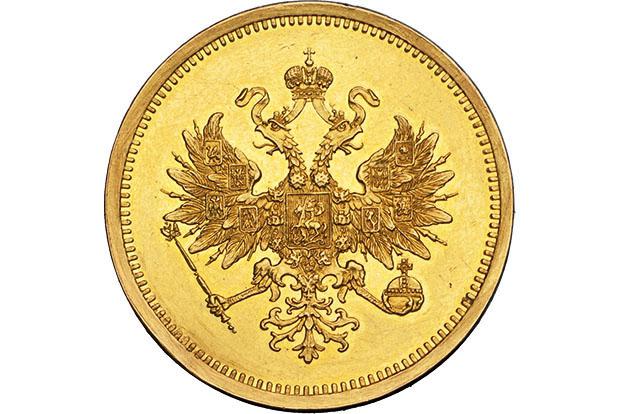
Price: 5, 5 million rubles
In the entire history of the Russian Empire coin of 25 rubles were minted only three times - under Alexander II and Nicholas II. They were produced to the highest order and intended for gifts. In January 1876 at the Saint Petersburg Mint produced 100 gold dvadtsatipyatirublevok. Recipient of the coin was the Grand Duke Vladimir Alexandrovich, brother of Emperor Alexander III. Perhaps the order has been associated with the forthcoming appointment of Vladimir Alexandrovich President of the Imperial Academy of Arts and triumph on this occasion.
25 rubles 1876 (reverse)

Despite its rarity, dvadtsatipyatirublevki 1876 has been constantly appear on the Russian and foreign auctions - two or three times a year, and even more (according to the numismatic portal "Mint"). They invariably expensive, but the final price depends on the number of people wishing to buy them. In April 2013, at the auction "Coins and Medals" 25 rubles in 1876 after a brief bargaining sold for 5, 5 million rubles. Six months earlier, at the same auction dvadtsatipyatirublevka similar safety soared in price up to 9, 5 million rubles.
10 rubles 1896

Price: 10, 1 million rubles
At the beginning of the reign of Nicholas II gold desyatirublevki (Imperials) minted symbolic circulation - 150 copies in 1895, 1896 and 1897. The government is preparing a reform that was supposed to eliminate the current imbalance value of the credit and gold ruble (1, 5: 1) and rigidly tied to the paper ruble gold. In 1898 came into circulation new gold five- and desyatirublevki - one and a half times lighter than the former.
Recent imperials immediately became a rarity in the pre-revolutionary catalog VI Petrov estimated at 50-100 rubles per copy (depending on the state). In September 2013 at the auction house "Alexander" Imperial 1896 excellent preservation was sold for 10, 1 million rubles. Price phenomenal - in February 2012 in the German auction Kuenker Imperial ideally as proof went for € 140 000 (about 5 to 6 million rubles at the exchange rate).
Source Your text to link ...
If a couple of years ago, the top lots were numismatic auctions coins, which went 2-4 at the price of 5 million rubles, but this year the cost - 5-7, 5 million rubles. From January to October auction firm "Coins and Medals", "Alexander", "East European antique house", "Imperiya" and "Russian House numismatic" coins sold over 4600 pre-Petrine Russia, the Russian Empire, the Soviet Union and modern Russia in excess 500 million rubles (excluding fees from customers). With about 100 coins left at the price of 1 million rubles to 10, 2 million rubles.
"High demand, as always, are rare things, especially supersohrannosti", - said Igor Lavruk, CEO "of coins and medals", the largest in terms of revenue numismatic firm. - It is good to buy very cheap coin - a sign that the market appeared novice collectors. " However, in the medium price segment (coins from 300 000 to 900 000), the situation is different - many items are removed from the auction due to lack of bids. Most wealthy collectors such coins are already available, and beginners are not ready to buy them. Nevertheless, says Lavruk lower price will no longer: the post-crisis recession has passed. The market is clearly on the rise, agrees banker and collector Sergei Yunin that established in late 2012. "The Eastern European antique house." "The more I was immersed in the antique market and, in particular, in numismatics, the more he did not believe his luck! - He says. - Agreed several favorable factors, and first among them - the extreme volatility in the financial markets, traditionally defined escape into gold, the Swiss franc, antiques, real estate ».
Introducing the most expensive lots in Moscow numismatic auctions, prices of which are in the course of trading exceeded 5 million rubles.
Poltina 1843 (obverse)

Price: 10, 2 million rubles
If this poltina in 1843 was released at the Warsaw Mint, now even at UNC (with no trace of treatment) would cost no more than $ 5,000. But it is minted in St. Petersburg as a proof - polished stamps on the polished workpiece and therefore is ten times more expensive. As a rule, proof coins were intended to demonstrate the quality of the mint, and coincided with the dates of the draw stamping. In 1843, at the Saint Petersburg Mint poltinas not minted for circulation and a copy of proof, apparently, produced on special order.
Poltina 1843 (reverse)

Being one of the rarest coins middle of the XIX century, in the June auction "East European antique house" poltina went for 10, 2 million rubles. It has been reported that the coin comes from the old foreign collections and put up for auction for the second time in the history of numismatic auctions. It seems that it was sold in October 2012 at an auction Sincona for 240,000 Swiss francs (about 8, 7 million rubles at the exchange rate). With commission auction houses, the previous owner earned on resale poltinas not too much - about 500 000 rubles.
Ducat 1729

Price: 5, 3 million rubles
Emperor Peter II, grandson of Peter the Great, the rules for long - less than three years. Gold coins were minted with him only once - in 1729, when the College of Foreign Affairs of the needed gold for their own needs. The mint raw gold was not enough, so the redistribution of low-value products went from the Armory and gold dvuhrublevye coins minted during the reign of Peter I and Catherine I. The College of Foreign Affairs received 17,000 ducats.
But over the centuries, thousands of "disappeared" and turned into dozens. Peter II gold coins are considered very rare. In March 2013 gold coin in 1729 in the state AUNC (almost without a trace of treatment) at auction "Alexander" went for 5, 3 million rubles. Appears on its face, this is the coin in November 2012, was sold at auction Numismatica Genevensis 85 000 Swiss francs (2, 8 million rubles at the exchange rate).
1 ruble 1839 (obverse)

Price: 7, 5 million rubles
The circulation of silver rubles during the reign of Nicholas I counted in millions and hundreds of thousands of pieces. It was only in 1839 ruble coins minted just 30,000, including multiple instances as proof.
1 ruble 1839 (reverse)

In October 2013 at an auction firm "Coins and Medals" ruble 1839 proof was bought for 7, 5 million rubles. Ten years earlier, the same auction house sold the same coin for 600 000 rubles. For comparison, the stock exchange gold for 2003-2013 years has risen in price in 3, 4 times.
1 ruble 1801 (reverse)

Price: 7, 25 million rubles
In the year of accession to the throne of Alexander I ruble coins for circulation were not issued. Therefore available in the collection rubleviki with a portrait of the young emperor, eagle stamp and the date "1801" refers to trial. For the most part they considered to remake - coins minted authentic and refined stamps in the middle - the second half of the XIX century.
However, authoritative numismatist-scholar Basil Uzdenikov believed that no trial rubles did not exist, and for remakes was used unapproved version of the portrait medal stamp to commemorate the coronation of Alexander I. Whatever it was, Euro 1801 has always been highly valued by collectors.
1 ruble 1801 (obverse)

Known variants of these seven rubles differing nuances of issue and details front and back sides. The rarest of them who still believe this trial, in October 2013 was sold at auction "Coins and Medals" for 7, 25 million rubles. The same coin, but a better safety at the April 2006 auction went for 2, 8 million rubles.
Ducat 1712

Price: 6, 1 million rubles
Gold coins in Tsarist Russia was referred to a ten banknotes, as in Soviet times, and coins in the European Champion ducats (in the beginning of the XVIII century, one gold piece corresponded to about 2-2, 25 Russian rubles). They began to mint under Peter I for International Settlements, and for the sake of political prestige. His gold in Russia was not, and for coinage Treasury purchased through Siberian merchants Rassypnoe Chinese gold. Circulations ducats were therefore low. So, in January 1712 at the Red Mint in Moscow produced about 4500 ducats. Survived quite a bit of gold. At the auction house "Imperiya" in March 2013 gold coin in 1712 (the most rare species - "small head buckle cloak") was bought for 6, 1 million rubles. The same coin at auction "Coins and Medals" in April 2006, was sold for 1, 1 million rubles.
25 rubles 1876 (obverse)

Price: 5, 5 million rubles
In the entire history of the Russian Empire coin of 25 rubles were minted only three times - under Alexander II and Nicholas II. They were produced to the highest order and intended for gifts. In January 1876 at the Saint Petersburg Mint produced 100 gold dvadtsatipyatirublevok. Recipient of the coin was the Grand Duke Vladimir Alexandrovich, brother of Emperor Alexander III. Perhaps the order has been associated with the forthcoming appointment of Vladimir Alexandrovich President of the Imperial Academy of Arts and triumph on this occasion.
25 rubles 1876 (reverse)

Despite its rarity, dvadtsatipyatirublevki 1876 has been constantly appear on the Russian and foreign auctions - two or three times a year, and even more (according to the numismatic portal "Mint"). They invariably expensive, but the final price depends on the number of people wishing to buy them. In April 2013, at the auction "Coins and Medals" 25 rubles in 1876 after a brief bargaining sold for 5, 5 million rubles. Six months earlier, at the same auction dvadtsatipyatirublevka similar safety soared in price up to 9, 5 million rubles.
10 rubles 1896

Price: 10, 1 million rubles
At the beginning of the reign of Nicholas II gold desyatirublevki (Imperials) minted symbolic circulation - 150 copies in 1895, 1896 and 1897. The government is preparing a reform that was supposed to eliminate the current imbalance value of the credit and gold ruble (1, 5: 1) and rigidly tied to the paper ruble gold. In 1898 came into circulation new gold five- and desyatirublevki - one and a half times lighter than the former.
Recent imperials immediately became a rarity in the pre-revolutionary catalog VI Petrov estimated at 50-100 rubles per copy (depending on the state). In September 2013 at the auction house "Alexander" Imperial 1896 excellent preservation was sold for 10, 1 million rubles. Price phenomenal - in February 2012 in the German auction Kuenker Imperial ideally as proof went for € 140 000 (about 5 to 6 million rubles at the exchange rate).
Source Your text to link ...
Tags
See also
6 most talked about divorce Russian show business since the beginning of 2013
Technological trends in 2013
The most expensive gadgets in the world (16 photos + video)
The most interesting films in 2013
The most expensive coin
7 most expensive ...
Where and how do the most expensive metal in the world
Interesting facts about most expensive food
Scientists have named 2013 the hottest in the last 150 years
The most expensive diamonds

















